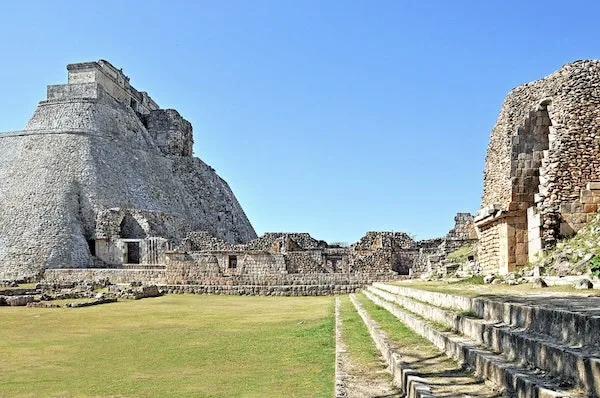Mexico
Mexico Trips: Where the ancient world collides with modernity
Enigmatic, exciting, and exuberant, Mexico has everything a traveler could wish for. Its world-class food, gorgeous beaches, and dramatic landscapes like deserts, mountains, and rainforests, would be enough for most visitors.
But the real magic lies in the country’s rich cultural blend—ancient Mayan and Aztec ruins stand alongside modern architecture and cutting-edge cityscapes in Mexico City and Guadalajara. Throw in friendly locals, world-class museums, and iconic festivals such as the Day of the Dead and you’ll get an unforgettable trip through this most celebrated of Latin American destinations.

Want to learn more?
Mexico trip information
Quick details about Mexico
Electricity: 127V, 60 Hz. Plug types A/B.
Currency: Peso.
Language: Spanish.
ATMs: To withdraw $100 or more, use an ATM, but for less, it’s better to go to a casa de cambio to exchange smaller amounts.
Telephone: +52.
Best things to do in Mexico
Visit ruins: Mexico has no shortage of wondrous archaeological sites. You can tap into Mayan culture at Tulum, Palenque, and Chichen Itza, and witness the grandeur of the Aztecs at Tenochtitlán.
Swim in cenotes: The Yucatan peninsula is dotted with multi-colored subterranean pools that are a wonderful tonic to the humid rainforest.
Street food: You haven’t been to Mexico if you haven’t eaten a taco al pastor from a market stand. There are few better places to sample Mexico’s unrivaled gastronomy than Oaxaca, home of the famous mole sauce!
Sample art in Mexico City: Witness Diego Rivera’s iconic murals at the Palacio Nacional and take a trip to Frida Kahlo’s ‘Blue House’ for a memorable introduction to Mexico’s artistic treasures.
Visit a magic town: Mexico has more than 130 pueblos magicos (magic towns) which have been designated as places of exceptional cultural heritage. A famous example is the gorgeous San Miguel de Allende, which was also made a UNESCO World Heritage site.
Food and drink
Mexican food is so much more than tortillas and tacos. To sample the true diversity of the national cuisine, look for:
Chilaquiles – This breakfast staple consists of lightly fried corn tortillas cut into quarters and topped with green or red salsa, shredded chicken, and cheese. It’s hearty, flavorful, and beloved across Mexico.
Dorilocos – This quirky snack involves a bag of Doritos cut open and loaded with toppings like peanuts, lime, hot sauce, and pickled pork rind.
Camotes – A dessert made from roasted sweet potatoes, often sold by street vendors. Camotes are usually served with condensed milk, fruit syrups, or cinnamon.
For a unique insight into Mayan cooking, try a Mayan pib – a dish prepared in an underground oven, often featuring smoky, marinated meats or tamales.
Staying healthy
Drinking the tap water in Mexico is not recommended. Bottled water is cheap and plentiful across the country. If you want to try street food, it’s best to choose popular vendors with high turnovers of locals.
Mexico can be hot and humid – sunscreen and insect repellent are indispensable!
Festivals and celebrations in Mexico
Day of the Dead (Dia de los Muertos) – November 1,2
No festival is more emblematic of Mexico than this blockbuster event that honors deceased loved ones and should not be missed.
Semana Santa (Easter)
Easter is a big deal in Latin America and Mexico is no exception. Expect parades, reenactments of the Passion of the Christ, and lots of unique local traditions.
Independence Day (September 16)
Celebrated across the country with fireworks, parties, and parades.
Mexico travel guides
The Rough Guide and Lonely Planet are reliable and popular resources. There are also plenty of blogs, guides, and videos, as well as some excellent blogs about sustainable travel, such as:
https://www.wakefultravel.com/blogs/journal/the-ultimate-guide-to-ecotourism-in-mexico
Sustainable projects in Mexico
Programs like WWOOF (World Wide Opportunities on Organic Farms) or Earthwatch offer hands-on experience in sustainability, from organic farming to conservation. These opportunities allow participants to learn directly from experts while contributing to meaningful environmental projects.
Sustainable hotels and places to stay
Olas Tulum – this stylist eco-lodge on the Riviera Maya champions local food sourcing and fosters connections with Tulum’s community. It also features solar power, rainwater harvesting, ecological architecture, and waste recycling systems like composting and advanced septic technology.
Genesis Eco Oasis in the Yucutan province embraces eco-conscious practices through gray water recycling, natural purification systems, and the use of sustainable materials like thatched roofs. It supports local traditions, serves fresh organic produce, and reduces energy consumption by harnessing its tropical climate.
El Madresal in Chiapas utilizes clean energy and implements a quality management system to balance visitor satisfaction with wetland conservation.
Subscribe to our newsletter
Frequently asked questions
What are the travel requirements for entry to Mexico?
US citizens are granted a 180-day tourist visa on arrival in Mexico and only need to show a valid passport and proof of a return trip. You’ll be asked to complete a migration form on arrival and provide an address for your stay in the country. You should check the International Travel section of the US Dept of State website for the most up-to-date information about Mexico.
Is it safe to visit Mexico?
When is the best time to visit Mexico?
The best time to visit Mexico is between November and April as you’ll enjoy the sunniest and driest weather (but the most crowds). November is also when the Day of the Dead celebrations occur. If you’d prefer fewer crowds and lusher vegetation, then the rainy season might be preferable.
What is the weather like?
Seasons vary in Mexico, with cooler weather from December to February. The hurricane season is from June to November, affecting the Pacific and Atlantic coasts. Hurricanes can cause flooding and landscapes and can impact transport. Weather varies massively over this country, with dry heat in the northern deserts, relatively cool in the central mountainous areas, and humid heat in Chiapas and the Yucatan Peninsula in the south, where it gets up to 40 degrees Celsius in June and July.
What is the best place for students?
Mexico City is naturally the hub of national museums and galleries, so to see the best collections and representations of Mexican culture, there’s nowhere else that compares. You can also visit Teotihuacan, arguably the most impressive ruins in Mexico, and the largest and liveliest markets and nightlife. There are many great places for students to visit around the country, but Mexico City is a must.
How much should you tip in Mexico?
It is customary in Mexico to add 10-15% to your restaurant bill (if it hasn’t been added automatically). Expect to tip up to 20% in high-end places and for excellent service. You should always tip tour guides for around $5-10 each.
Is Mexico easy to travel around?
Mexico is a relatively easy country to travel in. Every major city and tourist destination is served by internal flights from a range of well-established domestic carriers like Aeromexico and Volaris. For travelers on more of a budget, there is a reliable and comfortable bus network to navigate between cities.
What’s the best way to get to Mexico?
For North American travelers, the best way of reaching Mexico is by air. There are plenty of direct flights to a wide range of Mexican cities such as Mexico City, Cancun, and Guadalajara. It is also possible to drive across the border with the US, especially if you are coming from neighboring states such as Texas or California.
What vaccinations are required for Mexico?
There are currently no mandatory vaccinations required to enter Mexico, including COVID-19 and yellow fever. It’s a good idea to make sure you’re up-to-date with routine jabs such as MMR, typhoid, tetanus, and hepatitis A. For the most recent information before your trip, check the CDC’s Mexico page.
